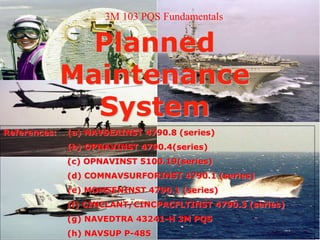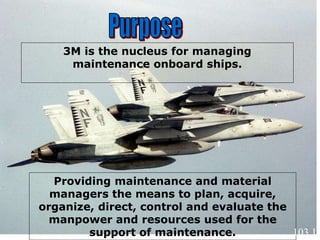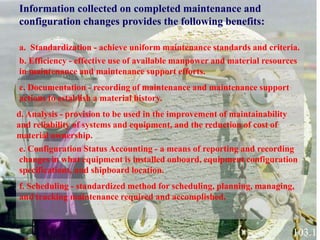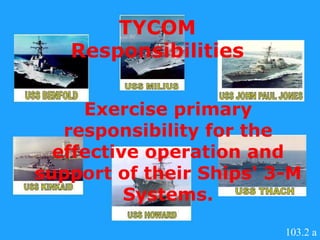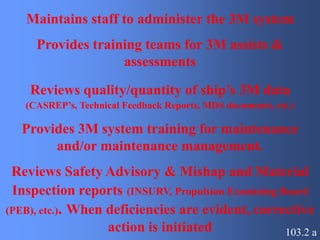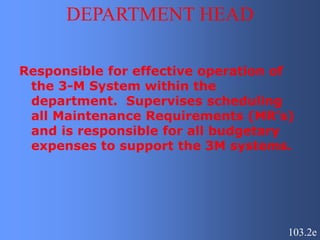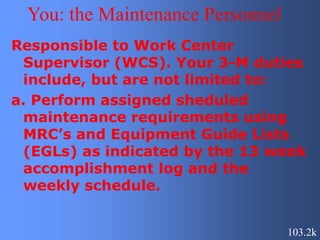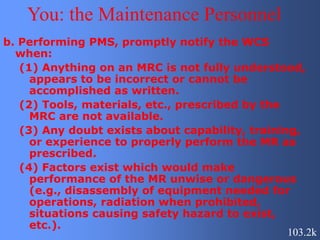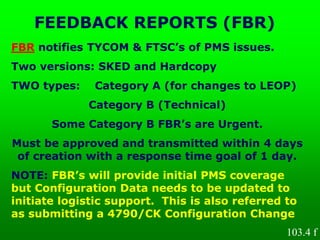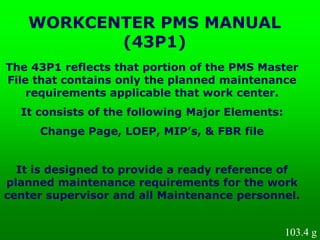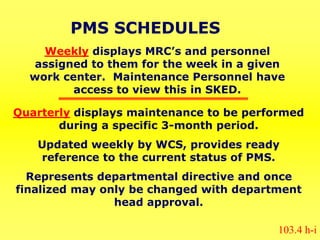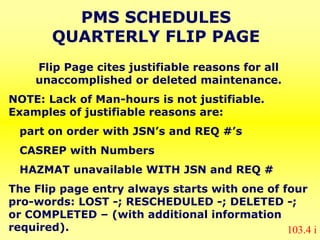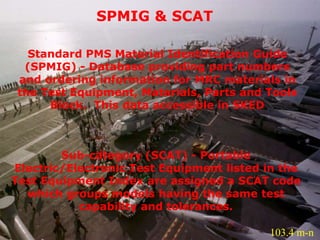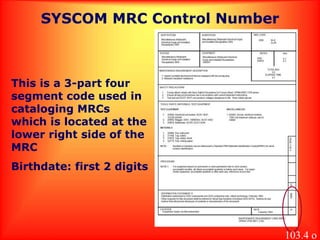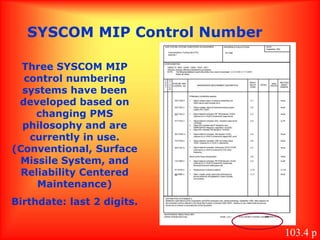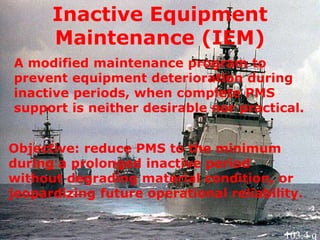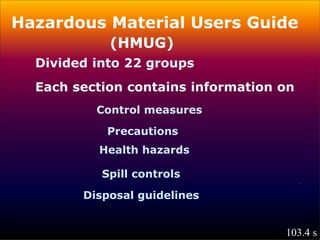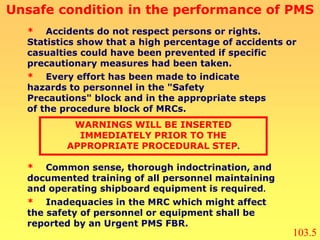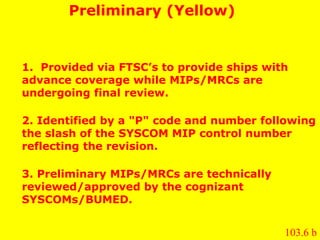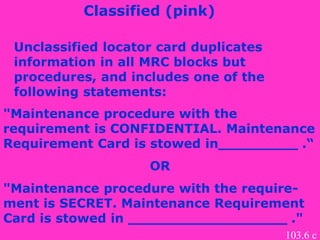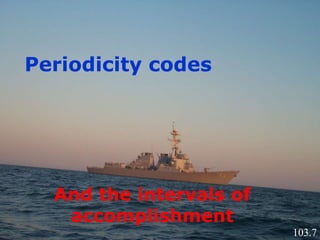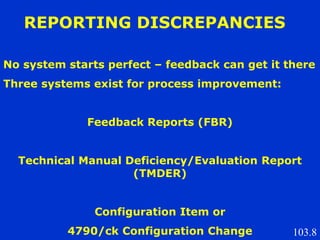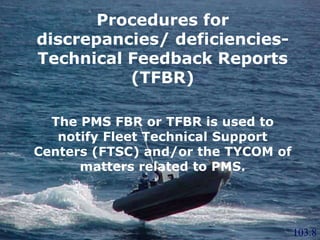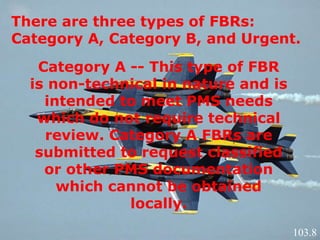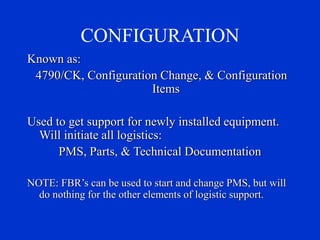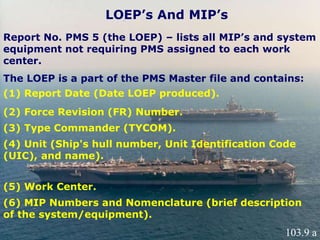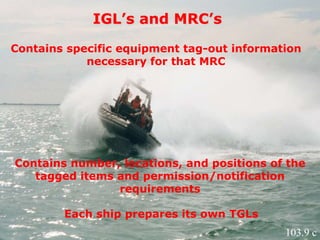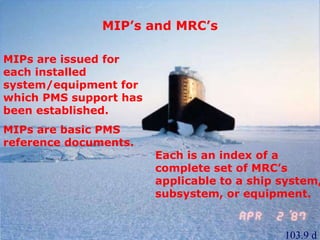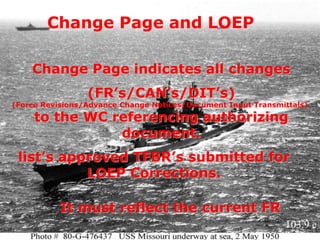planning maintenance system for engineers
- 1. Planned Maintenance System References: (a) NAVSEAINST 4790.8 (series) (b) OPNAVINST 4790.4(series) (c) OPNAVINST 5100.19(series) (d) COMNAVSURFORINST 4790.1 (series) (e) MOMSENINST 4790.1 (series) (f) CINCLANT/CINCPACFLTINST 4790.3 (series) (g) NAVEDTRA 43241-H 3M PQS (h) NAVSUP P-485 3M 103 PQS Fundamentals
- 2. Providing maintenance and material managers the means to plan, acquire, organize, direct, control and evaluate the manpower and resources used for the support of maintenance. 3M is the nucleus for managing maintenance onboard ships. 103.1
- 3. a. Standardization - achieve uniform maintenance standards and criteria. b. Efficiency - effective use of available manpower and material resources in maintenance and maintenance support efforts. c. Documentation - recording of maintenance and maintenance support actions to establish a material history. d. Analysis - provision to be used in the improvement of maintainability and reliability of systems and equipment, and the reduction of cost of material ownership. e. Configuration Status Accounting - a means of reporting and recording changes in what equipment is installed onboard, equipment configuration specifications, and shipboard location. f. Scheduling - standardized method for scheduling, planning, managing, and tracking maintenance required and accomplished. Information collected on completed maintenance and configuration changes provides the following benefits: 103.1
- 4. Duties, Responsibilities and the 3M chain of Command 103.2
- 5. TYCOM Responsibilities Exercise primary responsibility for the effective operation and support of their Ships' 3-M Systems. 103.2 a
- 6. Maintains staff to administer the 3M system Provides training teams for 3M assists & assessments Reviews quality/quantity of ship’s 3M data (CASREP’s, Technical Feedback Reports, MDS documents, etc.) Provides 3M system training for maintenance and/or maintenance management. Reviews Safety Advisory & Mishap and Material Inspection reports (INSURV, Propulsion Examining Board (PEB), etc.). When deficiencies are evident, corrective action is initiated 103.2 a
- 7. SHIPBOARD ORGANIZATION DUTIES AND RESPONSIBILITIES 3M SYSTEMS COORDINATOR DEPARTMENTAL 3-M SYSTEMS ASSISTANT WORK CENTER MAINT. PERSONNER WORK CENTER SUPERVISOR GROUP SUPERVISOR DIVISION OFFICER DEPARTMENT HEAD EXECUTIVE OFFICER 3M SYSTEM MANAGER COMMANDING OFFICER 103.2
- 8. CO - overall responsible for ensuring ship maintenance is accomplished following 3-M System procedures and that the 3-M System functions effectively within the command. XO - Ships' 3-M System manager and responsible to CO for overall management of the Ship’s 3-M program. 3-M System Coordinator (3MC) - functional manager of 3-M System and responsible to the XO for coordination and direct supervision of all administrative facets of the Ship’s 3-M System program. 103.2 b-d
- 9. DEPARTMENT HEAD 103.2e Responsible for effective operation of the 3-M System within the department. Supervises scheduling all Maintenance Requirements (MR’s) and is responsible for all budgetary expenses to support the 3M systems.
- 10. DIVISION OFFICER 103.2 f Trained in the 3-M System and responsible to the Department Head. Assists in managing the maintenance required for the division’s equipment, and is responsible for documentation accuracy. Conducts and manages divisional 3M training.
- 11. DEPARTMENTAL 3M 103.2 g Responsible to 3MC and Department Head for preparation and submission of all departmental 3M reports (spot- checks, PMS, Equipment Validations, etc.). Maintains the EGL master copies for each MRC in the Department. Assists Division Officers in achieving required 3M Systems training.
- 12. Division CPO’s who are responsible for two or more work centers shall be referred to as “Group Supervisors" Group Supervisors shall be responsible for the proper performance of the 3-M System functions within their work centers. The Work Center Supervisor is responsible for the effective operation of the 3-M System within the work center This responsibility shall not be delegated Work Center Supervisors receive additional 3-M System training Group and Work Center Supervisors 103.2h & i
- 13. REPAIR PARTS PETTY OFFICER RPPO – Interfaces with Supply for ordering parts and supplies required for all associated workcenters. Conducts monthly Material Obligation Validations (MOV’s) with the Department Head to validate the continued need for parts ordered. 103.2 j
- 14. You: the Maintenance Personnel Responsible to Work Center Supervisor (WCS). Your 3-M duties include, but are not limited to: a. Perform assigned sheduled maintenance requirements using MRC’s and Equipment Guide Lists (EGLs) as indicated by the 13 week accomplishment log and the weekly schedule. 103.2k
- 15. You: the Maintenance Personnel b. Performing PMS, promptly notify the WCS when: (1) Anything on an MRC is not fully understood, appears to be incorrect or cannot be accomplished as written. (2) Tools, materials, etc., prescribed by the MRC are not available. (3) Any doubt exists about capability, training, or experience to properly perform the MR as prescribed. (4) Factors exist which would make performance of the MR unwise or dangerous (e.g., disassembly of equipment needed for operations, radiation when prohibited, situations causing safety hazard to exist, etc.). 103.2k
- 16. 3-M is a management tool designed to provide efficient, uniform methods of conducting and recording preventive and corrective maintenance. Preventive maintenance: actions intended to prevent or discover functional failures. Preventive maintenance includes actions taken to prevent equipment from failing, such as changing the oil, cleaning filters, calibrating, etc. Corrective maintenance: actions taken to fix equipment that has failed or is not working to design specifications. Included in the phrase "corrective maintenance" are authorized changes or modifications to installed equipment. Corrective and Preventive Maintenance 103.3
- 17. Maintenance Requirement Card (MRC) – step-by- step procedures with safety precautions noted describing who, what, how, and with what resources an MR will be accomplished. Equipment Guide List (EGL) - used when an MRC applies to a number of identical items (i.e., valves, small arms, etc.). Each item will be uniquely identified. Each ship prepares its own EGLs. Purpose of the 3M elements Maintenance Index Page (MIP) – Index of MRC’s prepared and issued for each system/equipment onboard for which PMS exists. MRC’s, EGL’s, & MIP’s are basic PMS documents. 103.4 a-c
- 18. List of Effective Pages (LOEP) - lists MIP’s and system equipment not requiring PMS assigned to each work center. Change Page – Historical Listing of all authorized changes made to the Work Center Manual (43P1) citing specific references authorizing each change. 3M ELEMENTS (con’t) 103.4 d-e The LOEP, Change Page, & MIP’s are key elements of the 43P1
- 19. FBR notifies TYCOM & FTSC’s of PMS issues. Two versions: SKED and Hardcopy TWO types: Category A (for changes to LEOP) Category B (Technical) Some Category B FBR’s are Urgent. Must be approved and transmitted within 4 days of creation with a response time goal of 1 day. NOTE: FBR’s will provide initial PMS coverage but Configuration Data needs to be updated to initiate logistic support. This is also referred to as submitting a 4790/CK Configuration Change FEEDBACK REPORTS (FBR) 103.4 f
- 20. The 43P1 reflects that portion of the PMS Master File that contains only the planned maintenance requirements applicable that work center. It consists of the following Major Elements: Change Page, LOEP, MIP’s, & FBR file It is designed to provide a ready reference of planned maintenance requirements for the work center supervisor and all Maintenance personnel. WORKCENTER PMS MANUAL (43P1) 103.4 g
- 21. Weekly displays MRC’s and personnel assigned to them for the week in a given work center. Maintenance Personnel have access to view this in SKED. Quarterly displays maintenance to be performed during a specific 3-month period. Updated weekly by WCS, provides ready reference to the current status of PMS. Represents departmental directive and once finalized may only be changed with department head approval. PMS SCHEDULES 103.4 h-i
- 22. Flip Page cites justifiable reasons for all unaccomplished or deleted maintenance. NOTE: Lack of Man-hours is not justifiable. Examples of justifiable reasons are: part on order with JSN’s and REQ #’s CASREP with Numbers HAZMAT unavailable WITH JSN and REQ # The Flip page entry always starts with one of four pro-words: LOST -; RESCHEDULED -; DELETED -; or COMPLETED – (with additional information required). PMS SCHEDULES QUARTERLY FLIP PAGE 103.4 i
- 23. Cycle displays PMS to be performed during the period between docking availabilities and/or three interdeployment training cycles. Any checks that have not been accomplished prior to restarting a cycle will be scheduled during the first quarter of the new cycle schedule. An example of such an availability is Docking Phased Maintenance Availability (DPMA). PMS SCHEDULES CYCLE 103.4j
- 24. Signature documentation of personal accomplishment of assigned MR’s after WCS notification and authorization. Documents associated Tag-outs and is reviewed weekly by the WCS & DivO Maintained in the 43P1 for not less than 13 weeks. 13 Week Accountability Log 103.4 k
- 25. Contains the information necessary for equipment tag-out maintenance. Regulated by the Tag Out Users Manual (TUMS) Created when existing technical documentation (EOSS, CSOSS, etc.) is insufficient to support tag-outs Signature Verified by WCS, DivO, and DH and re-verified when any one transfers Isolation Guide List (IGL) 103.4 l
- 26. Sub-category (SCAT) - Portable Electric/Electronic Test Equipment listed in the Test Equipment Index are assigned a SCAT code which groups models having the same test capability and tolerances. Standard PMS Material Identification Guide (SPMIG) - Database providing part numbers and ordering information for MRC materials in the Test Equipment, Materials, Parts and Tools Block. This data accessible in SKED SPMIG & SCAT 103.4 m-n
- 27. This is a 3-part four segment code used in cataloging MRCs which is located at the lower right side of the MRC Birthdate: first 2 digits SYSCOM MRC Control Number 103.4 o
- 28. SYSCOM MIP Control Number Three SYSCOM MIP control numbering systems have been developed based on changing PMS philosophy and are currently in use. (Conventional, Surface Missile System, and Reliability Centered Maintenance) Birthdate: last 2 digits. 103.4 p
- 29. Objective: reduce PMS to the minimum during a prolonged inactive period without degrading material condition, or jeopardizing future operational reliability. Inactive Equipment Maintenance (IEM) A modified maintenance program to prevent equipment deterioration during inactive periods, when complete PMS support is neither desirable nor practical. 103.4 q
- 30. • • Technical bulletins containing Technical bulletins containing information about the hazardous information about the hazardous material Material (HAZMAT) • • Shall be in English and contain at Shall be in English and contain at least the following information: least the following information: – – Identity of material Identity of material – – Hazardous ingredients Hazardous ingredients – – Physical and chemical characteristics Physical and chemical characteristics MSDS 103.4 r
- 31. – – Physical hazards (fire, explosion, Physical hazards (fire, explosion, reactivity) reactivity) – – Health hazards (routes of entry, Health hazards (routes of entry, exposure limits, and cancer potential) exposure limits, and cancer potential) – – Precautions for safe handling & use Precautions for safe handling & use – – Emergency first aid procedures Emergency first aid procedures – – MSDS preparation date MSDS preparation date – – Name, address & phone number of Name, address & phone number of chemical manufacturer, importer, chemical manufacturer, importer, employer who can provide additional employer who can provide additional information information MSDS (Con’t) 103.4 r
- 32. - (HMUG) Divided into 22 groups Each section contains information on Control measures Precautions Health hazards Spill controls Disposal guidelines Hazardous Material Users Guide 103.4 s
- 33. * Common sense, thorough indoctrination, and documented training of all personnel maintaining and operating shipboard equipment is required. * Accidents do not respect persons or rights. Statistics show that a high percentage of accidents or casualties could have been prevented if specific precautionary measures had been taken. * Every effort has been made to indicate hazards to personnel in the "Safety Precautions" block and in the appropriate steps of the procedure block of MRCs. WARNINGS WILL BE INSERTED IMMEDIATELY PRIOR TO THE APPROPRIATE PROCEDURAL STEP. * Inadequacies in the MRC which might affect the safety of personnel or equipment shall be reported by an Urgent PMS FBR. Unsafe condition in the performance of PMS 103.5
- 34. Provides detailed step-by-step procedures for performing maintenance and describes who, what, how, and with what resources a specific requirements will be accomplished. 3 types exist: Technically Validated (white) Maintenance Requirement Card (MRC): 103.6 Preliminary (Yellow) Classified (Pink) Most MRC’s are Technically validated
- 35. Preliminary (Yellow) 1. Provided via FTSC’s to provide ships with advance coverage while MIPs/MRCs are undergoing final review. 2. Identified by a "P" code and number following the slash of the SYSCOM MIP control number reflecting the revision. 3. Preliminary MIPs/MRCs are technically reviewed/approved by the cognizant SYSCOMs/BUMED. 103.6 b
- 36. Unclassified locator card duplicates information in all MRC blocks but procedures, and includes one of the following statements: Classified (pink) "Maintenance procedure with the requirement is CONFIDENTIAL. Maintenance Requirement Card is stowed in_________ .“ OR "Maintenance procedure with the require- ment is SECRET. Maintenance Requirement Card is stowed in __________________ ." 103.6 c
- 37. And the intervals of accomplishment Periodicity codes 103.7
- 38. Calendar Periodicities The only authorized periodicities are as follows: Q - Quarterly 4M - Every 4th month S - Semiannually 8M - Every 8th month A - Annually #M - Every # months D – Every day 2D - Every 2nd day 3D - Every 3rd day W - Weekly 2W - Every 2nd week 3W - Every 3rd week 2M - Every 2nd month 103.7 a
- 39. Non-Calendar Periodicities R - Situation Requirement U - Unscheduled Maintenance LU - Lay-Up PM - Periodic Maintenance SU - Start-Up OT - Operational Test Inactive Equipment Maintenance (IEM)
- 40. No system starts perfect – feedback can get it there Three systems exist for process improvement: Feedback Reports (FBR) Technical Manual Deficiency/Evaluation Report (TMDER) Configuration Item or 4790/ck Configuration Change REPORTING DISCREPANCIES 103.8
- 41. Procedures for discrepancies/ deficiencies- Technical Feedback Reports (TFBR) The PMS FBR or TFBR is used to notify Fleet Technical Support Centers (FTSC) and/or the TYCOM of matters related to PMS. 103.8
- 42. FBR FORM Two versions: SKED and Hardcopy SKED – Instructions are available in the help file, with some specific Do’s and Don’ts Hardcopy - composed of an original and four copies. Instructions for preparation and submission of the form are printed on the back of the last copy.
- 43. Category A -- This type of FBR is non-technical in nature and is intended to meet PMS needs which do not require technical review. Category A FBRs are submitted to request classified or other PMS documentation which cannot be obtained locally. There are three types of FBRs: Category A, Category B, and Urgent. 103.8
- 44. This type of FBR is technical in nature, and is used to report: Technical discrepancies inhibiting PMS performance. Shift of maintenance responsibilities. Requests for TYCOM assistance. Category B -- 103.8
- 45. When the reason for submission of a PMS FBR involves safety of personnel, ship, or equipment and relates to the technical requirements of PMS, the FBR will be considered URGENT. The message shall describe the unsafe procedures or conditions, and shall identify the MIP/MRC involved. URGENT Feedback Reports. 103.8
- 46. TMDER Used to correct Technical Manuals and Publications used in the maintenance of shipboard equipment. Accomplished either on-line via Distance Support or via Snail Mail using a form from the back of the Manual.
- 47. CONFIGURATION Known as: 4790/CK, Configuration Change, & Configuration Items Used to get support for newly installed equipment. Will initiate all logistics: PMS, Parts, & Technical Documentation NOTE: FBR’s can be used to start and change PMS, but will do nothing for the other elements of logistic support.
- 48. Definitions and Relationships of the following: 103.9
- 49. Report No. PMS 5 (the LOEP) – lists all MIP’s and system equipment not requiring PMS assigned to each work center. The LOEP is a part of the PMS Master file and contains: LOEP’s And MIP’s (1) Report Date (Date LOEP produced). (2) Force Revision (FR) Number. (3) Type Commander (TYCOM). (4) Unit (Ship's hull number, Unit Identification Code (UIC), and name). (5) Work Center. (6) MIP Numbers and Nomenclature (brief description of the system/equipment). 103.9 a
- 50. EGL’s and MRC’s Specific EGL’s are created for each MRC when it applies to a number of identical items (i.e. valves, small arms, etc.) Each item on the EGL will have a unique identifier/serial number assigned. Each ship prepares its own EGLs. 103.9 b
- 51. IGL’s and MRC’s Contains specific equipment tag-out information necessary for that MRC Contains number, locations, and positions of the tagged items and permission/notification requirements Each ship prepares its own TGLs 103.9 c
- 52. MIPs are issued for each installed system/equipment for which PMS support has been established. MIPs are basic PMS reference documents. MIP’s and MRC’s Each is an index of a complete set of MRC’s applicable to a ship system, subsystem, or equipment. 103.9 d
- 53. Change Page and LOEP Change Page indicates all changes (FR’s/CAN’s/DIT’s) to the WC referencing authorizing document. list’s approved TFBR’s submitted for LOEP Corrections. It must reflect the current FR (Force Revisions/Advance Change Notices/Document Input Transmittals) 103.9 e
- 54. SAFETY PRECAUTIONS Warning: Death or injury may result if the operating/handling procedures and practices are not correctly followed. Warning text may be listed in the safety precautions‘ block and will be repeated preceding the procedure involved. Caution: Damage to equipment may result if the operating procedures and practices, etc. are not correctly followed. Cautions are not listed in safety precautions block but will precede the instruction for the procedure involved. 103.10 listed prior to applicable step on the MRC Specific categories are:

